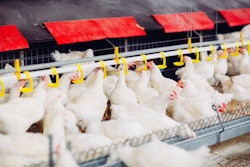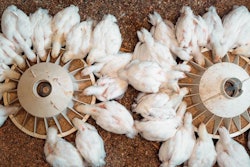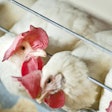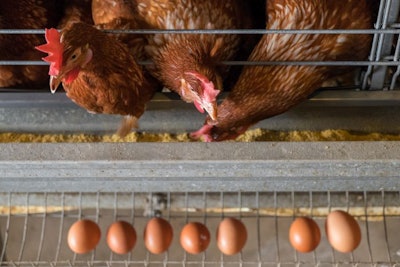
As egg size is manipulated, layer health, welfare and sustainability should be taken into account.
Pushing birds beyond their natural capacity for egg production puts them at risk of a range of health issues. It is important to consider the genetics, rearing and early and late-lay diets when looking to control egg size. Supporting egg quality and ensuring good health status are also essential.
More than half the eggs laid in Britain by free-range hens, for example, are classed as large or very large, which results in the other half being marked small or medium. Naturally, egg size will increase as hens get older; however, there is an increased demand from consumers and retailers for more large eggs.
A considerable price premium has been offered to producers for large eggs, but there are many considerations to take into account in terms of nutrition and health. Producing large eggs creates physiological and metabolic stresses on the birds, particularly in young and smaller hens — requiring careful management. The potential financial benefits need to be balanced with the sustainability benefits of longer cycles and ensuring egg quality.

Size issues, health problems
Usually free-range hens will lay 55% large and 45% medium, small and second-class eggs combined. Egg size can be affected by many variables, such as genetics, diet and lighting. The longer it takes to extend the daylight hours from 10 to 16 hours, the more sexually mature hens will be when they come into lay and, therefore, the larger the eggs will be.
When encouraging hens to lay large eggs, there is the potential for increased stress, feather loss or higher feed consumption. It can also result in high rates of second-quality eggs, prolapsed oviducts and secondary issues like egg peritonitis.
There is concern from the veterinary profession about the effect that producing more larger eggs has on the health and welfare of laying hens.
Their experience has shown that when egg size goes 1 to 2 grams over target for age in most breeds, issues are seen. However, some flocks cope with laying more large eggs, while others don’t. It’s important to remember that looking at average egg size only gives part of the picture.
There will naturally be a spread of egg weights in the flock, so if the average weight is 2 grams over target, then some eggs will be 4 grams heavier. It is these very large eggs that can cause damage to the vent and cloaca. This can lead to contamination and infection of the reproductive tract — with the potential for increased mortality.
The presence of blood also encourages pecking by other birds; hence, further damage.
Management considerations
Management and nutrition of birds in rear differs when large eggs are required. They are often at a higher body weight at the end of rear, but it is day length that stimulates the hens to come into lay. Breed manuals provide changes to lighting patterns depending on average body weight. However, just because they are heavier doesn’t necessarily mean that their reproductive organs are more developed, and their bodies may not be ready to produce eggs.
Flocks bought into lay more quickly can become stressed and an increase in aggressive behavior is seen.
It is not just the hen that can suffer as egg size increases, as larger eggs tend to have thinner shells. There is a limit to the amount of calcium carbonate a hen can access from her diet and bones (around 4 grams) so there is a finite quantity of shell she can produce for each egg. If she lays larger eggs for any reason, the shell must stretch more thinly, making the egg less robust. This will increase the number of seconds, causing waste as well as financial loss.
Nutritional basis
In general, a higher-density ration is used by those wanting to maximize the production of large eggs, particularly in early lay. These diets will include higher methionine levels to boost egg size which, along with more linoleic acid, increases the cost of the diet. However, it is important to remember that nutrient intake is also influenced by feed intake. If feed intake — and hence nutrient intake — increases later, egg size will increase further.
It is important to focus on the egg size required from the start and, by 30 weeks, the hen should be robust enough to lay for the next 40 to 50. If egg weight gets too high, too soon, it will affect the longevity of bird. Close monitoring of egg size, feed intake and diet specification is required to manage egg size profile and egg quality for the optimal economic return. It is important to measure feed intake vs. egg mass output to optimize feed efficiency and economic efficiency.
As flocks age, eggs get larger and shells tend to get thinner. This is thought to be due to the fact that mineral deposition does not increase along with egg weight. Therefore, the nutritionist’s aim should be to minimize any increase in size, while supporting eggshell quality.
As the hen ages, it may not be able to absorb and mobilize minerals as efficiently. This is when source and availability of minerals are particularly important. Supplementary calcium in large particle size later in lay is key, along with calcium phosphorus ratios, and optimal levels of vitamin D3 and selenium.
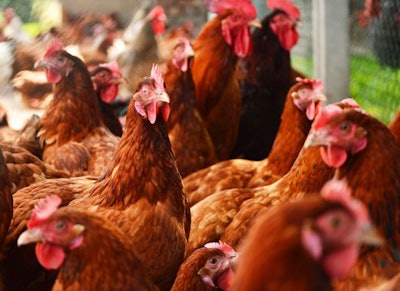 When increasing flock length, you may see a slight reduction in feed efficiency in the older bird, but more large eggs will be laid. (monticello | BigStock.com)
When increasing flock length, you may see a slight reduction in feed efficiency in the older bird, but more large eggs will be laid. (monticello | BigStock.com)Longer cycles
When producers want to increase laying cycle by six to eight weeks, egg size can become limiting. Producers need to get eggs of the right size but also the right quality, to maximize the profitability of the flock. It comes down to feeding the right diet at the right time to optimize nutrient efficiency — as well as monitoring production data.
Economic modeling has shown that there is a significant positive improvement on profitability of increasing flock length. There is a slight reduction in feed efficiency as happens naturally in the older bird, but you get more eggs laid. An increase in seconds is also to be expected with older birds, as the shells get thinner and more cracks appear. Everyone’s situation is different but, in general, there is an economic advantage to extending the laying period, without having to push the birds to lay larger eggs.
Sustainability
The greater potential losses of a poor-performing medium-egg flock, along with the greater potential profit of large eggs, are clear reasons why producers want to focus on the large egg market. However, there are wider sustainability issues to consider when thinking about the pressure to produce more large eggs. Longer cycles are more challenging in this situation, but longer cycles increase efficiency and sustainability.
There has been a lot of discussion about food waste, both in the home and at retailers. For eggs, shell quality is key to minimizing wastage and there is no doubt that large eggs have thinner shells. This increases the potential for wastage at the packer and retailer — even before it reaches the consumer’s kitchen.
However, where there is a high demand for large eggs, it is imperative that egg size is managed and it isn’t allowed to “run away,” which can have financial and welfare implications.

